AMD's Radeon HD 5870: Bringing About the Next Generation Of GPUs
by Ryan Smith on September 23, 2009 9:00 AM EST- Posted in
- GPUs
Power, Temperature, & Noise
As we have mentioned previously, one of AMD’s big design goals for the 5800 series was to get the idle power load significantly lower than that of the 4800 series. Officially the 4870 does 90W, the 4890 60W, and the 5870 should do 27W.
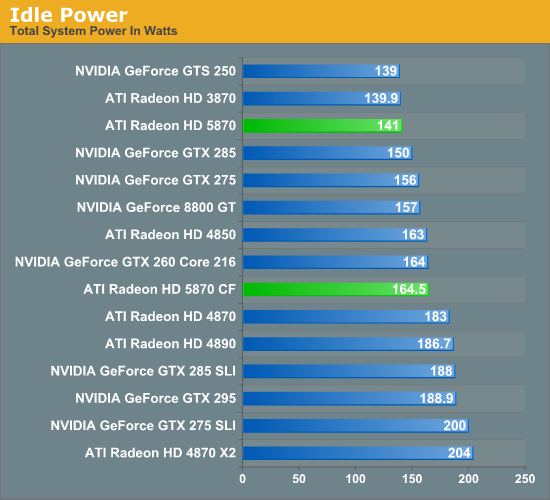
On our test bench, the idle power load of the system comes in at 141W, a good 42W lower than either the 4870 or 4890. The difference is even more pronounced when compared to the multi-GPU cards that the 5870 competes with performance wise, with the gap opening up to as much as 63W when compared to the 4870X2. In fact the only cards that the 5870 can’t beat are some of the slowest cards we have: the GTS 250 and the Radeon HD 3870.
As for the 5870 CF, we see AMD’s CF-specific power savings in play here. They told us they can get the second card down to 20W, and on our rig the power consumption of adding a second card is 23.5W, which after taking power inefficiencies into account is right on the dot.
Moving on to load power, we are using the latest version of the OCCT stress testing tool, as we have found that it creates the largest load out of any of the games and programs we have. As we stated in our look at Cypress’ power capabilities, OCCT is being actively throttled by AMD’s drivers on the 4000 and 3000 series hardware. So while this is the largest load we can generate on those cards, it’s not quite the largest load they could ever experience. For the 5000 series, any throttling would be done by the GPU’s own sensors, and only if the VRMs start to overload.
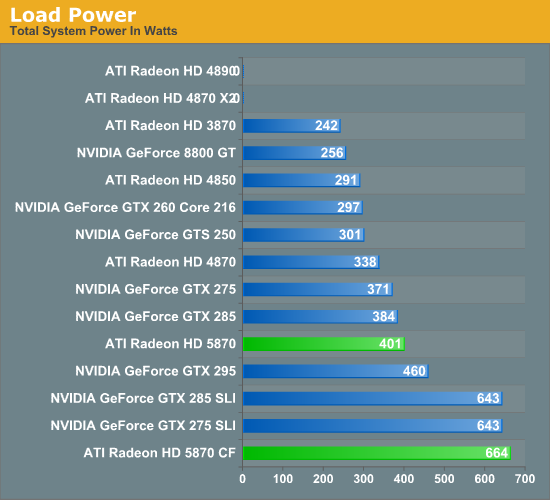
In spite of AMD’s throttling of the 4000 series, right off the bat we have two failures. Our 4870X2 and 4890 both crash the moment OCCT starts. If you ever wanted proof as to why AMD needed to move to hardware based overcurrent protection, you will get no better example of that than here.
For the cards that don’t fail the test, the 5870 ends up being the most power-hungry single-GPU card, at 401W total system power. This puts it slightly ahead of the GTX 285, and well, well behind any of the dual-GPU cards or configurations we are testing. Meanwhile the 5870 CF takes the cake, beating every other configuration for a load power of 664W. If we haven’t mentioned this already we will now: if you want to run multiple 5870s, you’re going to need a good power supply.
Ultimately with the throttling of OCCT it’s difficult to make accurate predictions about all possible cases. But from our tests with it, it looks like it’s fair to say that the 5870 has the capability to be a slightly bigger power hog than any previous single-GPU card.
In light of our results with OCCT, we have also taken load power results for our suite of cards when running World of Warcraft. As it’s not a stress-tester it should produce results more in line with what power consumption will look like with a regular game.

Right off the bat, system power consumption is significantly lower. The biggest power hogs are the are the GTX 285 and GTX 285 SLI for single and dual-GPU configurations respectively. The bulk of the lineup is the same in terms of what cards consume more power, but the 5870 has moved down the ladder, coming in behind the GTX 275 and ahead of the 4870.
Next up we have card temperatures, measured using the on-board sensors of the card. With a good cooler, lower idle power consumption should lead to lower idle temperatures.
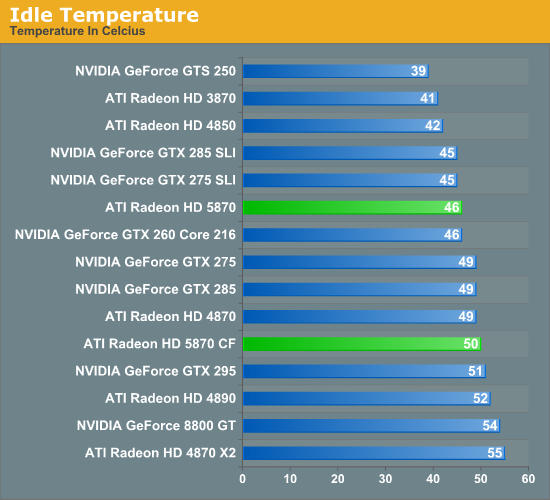
The floor for a good cooler looks to be about 40C, with the GTS 250, 3870, and 4850 all turning in temperatures around here. For the 5870, it comes in at 46C, which is enough to beat the 4870 and the NVIDIA GTX lineup.
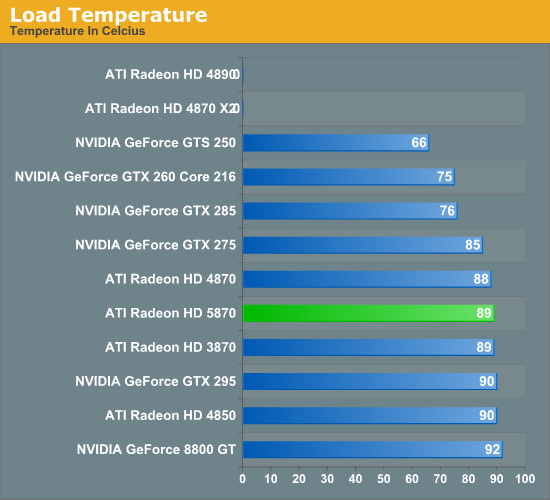
Unlike power consumption, load temperatures are all over the place. All of the AMD cards approach 90C, while NVIDIA’s cards are between 92C for an old 8800GT, and a relatively chilly 75C for the GTX 260. As far as the 5870 is concerned, this is solid proof that the half-slot exhaust vent isn’t going to cause any issues with cooling.
Finally we have fan noise, as measured 6” from the card. The noise floor for our setup is 40.4 dB.

All of the cards, save the GTX 295, generate practically the same amount of noise when idling. Given the lower energy consumption of the 5870 when idling, we had been expecting it to end up a bit quieter, but this was not to be.
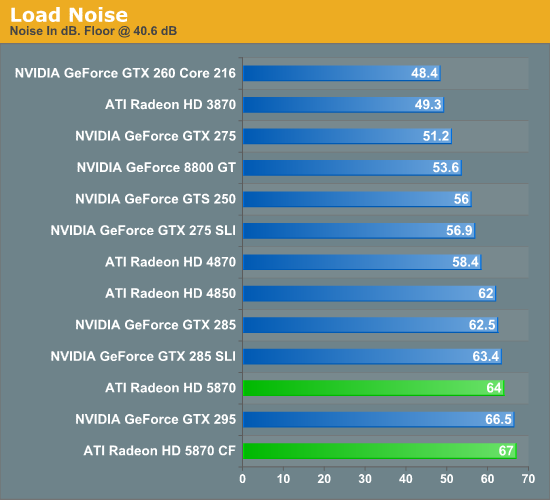
At load, the picture changes entirely. The more powerful the card the louder it tends to get, and the 5870 is no exception. At 64 dB it’s louder than everything other than the GTX 295 and a pair of 5870s. Hopefully this is something that the card manufacturers can improve on later on with custom coolers, as while 64 dB at 6" is not egregious it’s still an unwelcome increase in fan noise.










327 Comments
View All Comments
Zool - Sunday, September 27, 2009 - link
The speed of the on chip cache just shows that the external memory bandwith in curent gpus is only to get the data to gpu or recieve the final data from gpu. The raw processing hapenns on chip with those 10 times faster sram cache or else the raw teraflops would vanish.JarredWalton - Sunday, September 27, 2009 - link
If SD had any reading comprehension or understanding of tech, he would realize that what I am saying is:1) Memory bandwidth didn't double - it went up by just 23%
2) Look at the results and performance increased by far more than 23%
3) Ergo, the 4890 is not bandwidth limited in most cases, and there was no need to double the bandwidth.
Would more bandwidth help performance? Almost certainly, as the 5870 is such a high performance part that unlike the 4890 it could use more. Similarly, the 4870X2 has 50% more bandwidth than the 5870, but it's never 50% faster in our tests, so again it's obviously not bandwidth limited.
Was it that hard to understand? Nope, unless you are trying to pretend I put an ATI bias on everything I say. You're trying to start arguments again where there was none.
SiliconDoc - Sunday, September 27, 2009 - link
The 4800 data rate ram is faster vs former 3600 - hence bus width is running FASTER - so your simple conclusions are wrong.When we overlcock the 5870's ram, we get framerate increase - it increases the bandwidth, and up go the numbers.
---
Not like there isn't an argument, because you don't understand tech.
JarredWalton - Sunday, September 27, 2009 - link
The bus is indeed faster -- 4800 effective vs. 3900 on the 4890 or 3600 on the 4870. What's "wrong about my simple conclusions"? You're not wrong, but you're not 100% right if you suggest bandwidth is the only bottleneck.Naturally, as most games are at least partially bandwidth limited, if you overclock 10% you increase performance. The question is, does it increase linearly by 10%? Rarely, just as if you overclock the core 10% you usually don't get 10% boost. If you do get a 1-for-1 increase with overclocking, it indicates you are solely bottlenecked by that aspect of performance.
So my conclusions still stand: the 5870 is more bandwidth limited than 4890, but it is not completely bandwidth limited. Improving the caches will also help the GPU deal with less bandwidth, just as it does on CPUs. As fast as Bloomfield may be with triple-channel DDR3-1066 (25.6GB/s), the CPU can process far more data than RAM could hope to provide. Would a wider/faster bus help the 5870? Yup. Would it be a win-win scenario in terms of cost vs. performance? Apparently ATI didn't think so, and given how quickly sales numbers taper off above $300 for GPUs, I'm inclined to agree.
I'd also wager we're a lot more CPU limited on 5870 than many other GPUs, particularly with CrossFire setups. I wouldn't even look at 5870 CrossFire unless you're running a high-end/overclocked Core i7 or Phenom II (i.e. over ~3.4GHz).
And FWIW: Does any of this mean NVIDIA can't go a different route? Nope. GT300 can use 512-bit interfaces with GDDR5, and they can be faster than 5870. They'll probably cost more if that's the case, but then it's still up to the consumers to decide how much they're willing to spend.
silverblue - Saturday, September 26, 2009 - link
I suppose if we end up seeing a 512-bit card then it'll make for a very interesting comparison with the 5870. With equal clocks during testing, we'd have a far better idea, though I'd expect to see far more RAM on a 512-bit card which may serve to skew the figures and muddy the waters, so to speak.Voo - Friday, September 25, 2009 - link
Hey Jarred I know that's neither the right place nor the right person to ask, but do we get some kind of "Ignore this person" button with the site revamp Anand talked about some months ago?I think I'd prefer this feature about almost everything - even an edit button ;)
JarredWalton - Friday, September 25, 2009 - link
I'll ask and find out. I know that the comments are supposed to receive a nice overhaul, but more than that...? Of course, if you ignore his posts on this (and the responses), you'd only have about five comments! ;-)Voo - Saturday, September 26, 2009 - link
Great!Yep it'd be rather short, but I'd rather have 10 interesting comments than 1000 COMMENTS WRITTEN IN CAPS!!11 with dubious content ;)
SiliconDoc - Wednesday, September 30, 2009 - link
I put it in caps so you could easily avoid them, I was thinking of you and your "problems".I guess since you "knew this wasn't the right time or place" but went ahead anyway, you've got "lot's of problems".
Let me know when you have posted an "interesting comment" with no "dubios nature" to it.
I suspect I'll be waiting years.
MODEL3 - Friday, September 25, 2009 - link
Hi Ryan,Nice new info in your review.
The day you posted your review, i wrote in the forums that according to my perception there are other reasons except bandwidth limitations and driver maturity, that the 850MHz 5870 hasn't doubled its performance in relation with a 850MHz 4890.
Usually when a GPU has 2X the specs of another GPU the performance gain is 2X (of cource i am not talking about games with engines that are CPU limited or engines that seems to scale badly or are poor coded for example)
There are many examples in the past that we had 2X performance gain with 2X the specs. (not in all the games, but in many games)
From the tests that i saw in your review and from my understanding of the AMD slides, i think there are 2 more reasons that 5870 performs like that.
The day of your review i wrote to the forums the additional reasons that i think the 5870 performs like that, but nobody replied me.
I wrote that probably 5870 has:
1.Geometry/vertex performance issues (in the sense that it cannot generate 2X geometry in relation with 4890) (my main assumption)
or/and
2.Geometry/vertex shading performance issues (in the sense that the geometry shader [GS] cannot shade vertex with 2X speed in relation with 4890)(another possible assumption)
I guess there are synthetic benchmarks that have tests like that (pure geometry speed, and pure geometry/vertex shader speed, in addition with the classic pixel shader speed tests) so someone can see if my assumption is true.
If you have the time and you think that this is possible and you feel like it is worth your time, can you check my hypothesis please?
Thanks very much,
MODel3